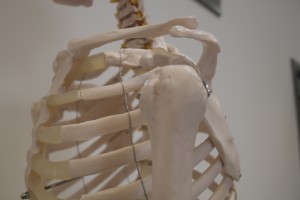Impingement syndrome

Rehab training for the injury
Rehab 1 – Rehab 2 – Rehab 3 – Rehab 4
Description of impingement syndrome
Based on the commonality of this injury impingement syndrome is the main reason for chronic shoulder pain. This problem refers to all the soft parts that lie above the head of the upper arm (caput humeri) and below the shoulder joint (acromion); the rotator-cuff muscles (shoulder stability muscles) and their tendons, the underlying bursa (subacromial bursa) and the long head of biceps (tendon of caput longum bicipitis of the biceps muscle).
What is the cause of impingement syndrome?
There are primarily 2 reasons; the internal and the external.
The external factors relate to overload of the soft parts around the shoulder joint. Often this occurs during sports activities like kayaking, swimming, rowing, and weightlifting. The internal factors are most often due to strength imbalance between the four rotator-cuff muscles and the rest of the muscles around the shoulder joint. In a healthy shoulder, you can perform powerful upward / outward movement of the arm using the deltoid muscle, that is if the rotator cuff is intact, holding the head of the humerus inside the cavity glenoidalis, regardless of the position of the arm. If, on the other hand, you have a weak rotator- cuff due to repeated microtraumas, overloading or aging, the caput humeri will move slightly upwards, thus taking up the space from the in the upper compartment of the joint made up of part of the collar bone and the upper part of the shoulder blade, and the soft parts become squeezed.
The first sign of impingement is repeated compression of the rotator-cuff tendons and the bursa under the shoulder in the joint (acromion). Tendons and bursa become irritated and inflammation develops. Gradually, the rotator cuff is increasingly damaged, leaving scar tissue and degeneration. As time goes by, calcification deposits can be formed that create a bump. This evil cycle will continue, and the extra bone deposits can cause small cracks in the rotator cuff. The irritation will spread chemically and affect the long tendon of the biceps muscle, which in turn may also develop inflammation. Swelling of the bursa and a tight joint cap can also lead to impingement syndrome.
Impingement syndrome can be divided into four stages:
- Edema in the supraspinatus tendon, coming from the use of the arm in the horizontal plane and above. This inflammatory condition can be located and treated. Often causes toothache-like pain and most commonly occurs in people under 25 years of age.
- Continuous irritation of the tendon from supraspinatus, the biceps tendon and subacromial bursa develop fibrosis and the structures swell. Here, too, these toothache-like pains often occur – often worst at night – and the people affected are often between 24 and 40 years old. This stage often responds to conservative treatment.
- Ved yderligere irritation af denne impingement tilstand opstår der nærings forandringer i vævene, som kan give overrivninger. Forekommer sjældent hos personer under 40 år. Personerne præsenterer ofte en længerevarende sygdomshistorie. I dette stadie ses ofte knogledannelser, og disse reagerer dårligt på konservativ behandling.
- This stage represents a complete rupture of the rotator cuff due to long-term irritation. This stage requires operational treatment.
The primary risk group is athletes who need a lot of force from their shoulder like swimmers, weightlifters, handball players, basketball players and other throw-related sports.
Symptoms of impingement syndrome
- Pain in the shoulder.
- The pain may get worse at night.
- Pain during outward and upward movement of the arm (painful arch).
- Pain during forward movement of the shoulder with the palm downward.
- Pain is provoked by horizontal movement of the arm across the body.
- Possible pain on the back of the arm (hand in the back pocket).
- Local point of pain on the shoulder.
- Pain on the front of the shoulder and arm.
- Possible “stiff” or frozen shoulder.
- Possible crepitation (sore feeling).
- Evt. smerte over 90º fremadføring og udadføring.
- Possible spasms between the shoulder blades (rhomboid muscles and upper / lower trapezius).
Examination of impingement syndrome
- Analysis / inspection / palpation / ROM.
- Shoulder – arm rhythm is observed.
- Possible cervical traction and compression test, to exclude neck injury.
- Impingement tests.
- Rotator cuff tests.
- Biceps test.
- Painful arch test.
Treatment of impingement syndrome
- Rest in acute phase.
- Rehab
- Cryotherapy (ice massage 3x 9 min.).
- Termobehandling (varme).
- Ultrasound for posterior joint capsule (continuous / pulsating), 1 Mhz, 1 W cm2.
- TENS.
- Massage of the upper arm, shoulder, shoulder blades and neck area.
- NSAIDs.
- Possible change of posture via. upper cross syndrome training.
- Kinesiology tape.
- K-Laser.
- Traumeel pills (2 tabl. 3 g. daily for 9 days).
What the doctor can do:
In more serious cases operation is necessary to create space in the narrowed joint cavity. Many doctors also choose to give a steroid injection, which is not a substitute for therapy.
Rehabilitation:
Strength and flexibility exercises through rehab training are the key to changing most impingement conditions. A carefully composed rehabilitation program is needed to get proper strength and flexibility in the shoulder again, and primarily with focus on the internal rotation. Rehabilitation should be done as soon as possible. If the injured person has been through surgery, start rehabilitation after 3-4 days.

Social Medier